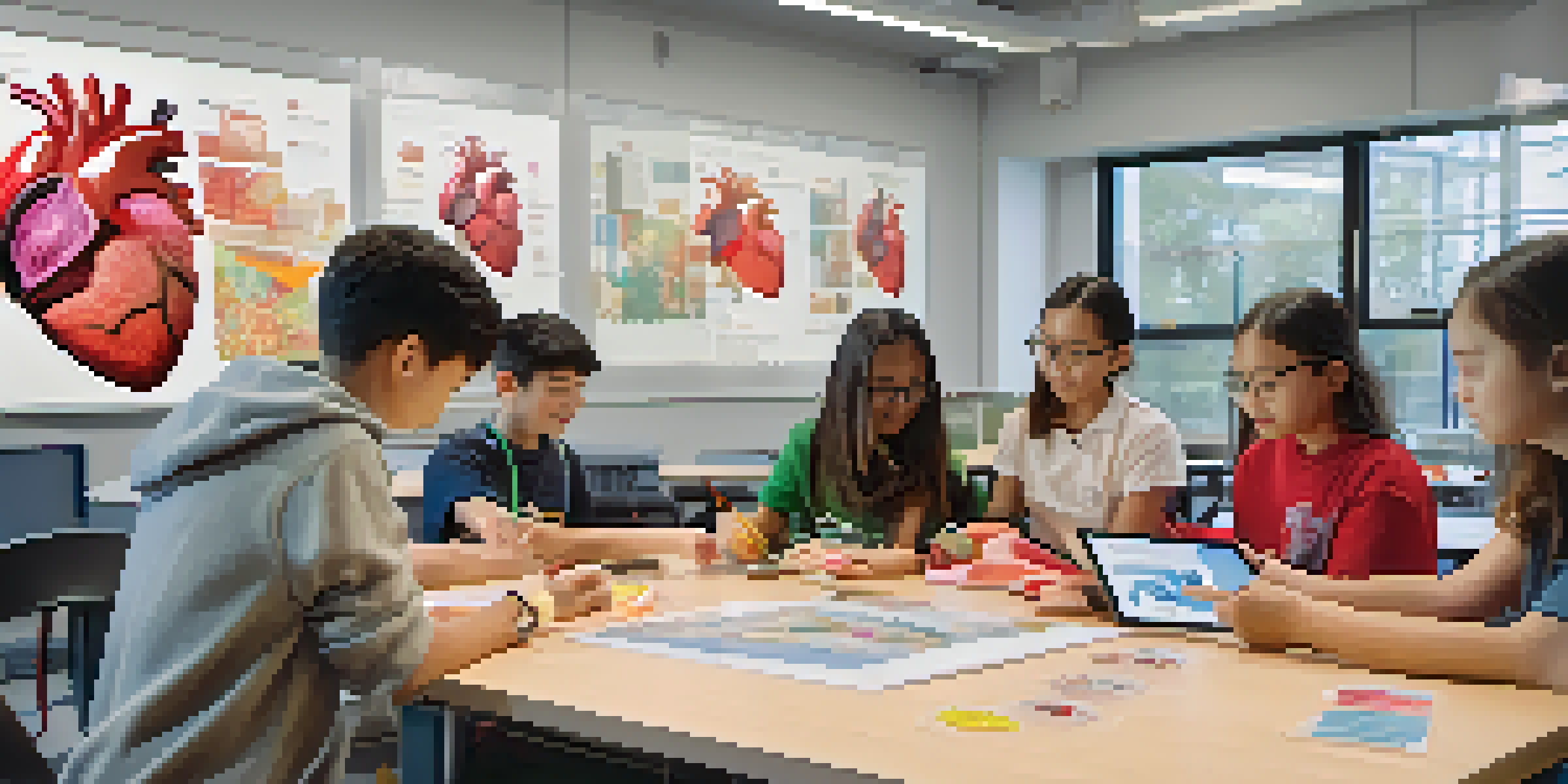AR-Based Assessments: Measuring Learning Outcomes Effectively

Understanding AR-Based Assessments in Education
Augmented Reality (AR) assessments are innovative tools that blend digital content with the real world. They allow learners to interact with educational material in ways that traditional assessments can't match. By overlaying information onto physical objects, AR can make learning more engaging and relatable.
Technology is best when it brings people together.
Imagine a biology student examining a 3D model of a human heart right in front of them, with the AR app highlighting different parts as they explore. This immersive experience not only retains attention but also deepens understanding, making complex information easier to grasp. AR assessments can also cater to various learning styles, accommodating diverse student needs.
As educators increasingly seek effective ways to measure learning outcomes, AR assessments provide a fresh perspective. They enable real-time feedback and data collection, offering insights into a student's understanding that can be more nuanced than standard tests.
Benefits of Using AR in Assessments
One of the main advantages of AR in assessments is its ability to create interactive experiences. This interactivity not only keeps students engaged but also encourages active learning, where learners participate and explore rather than simply memorizing facts. For example, a history student might use AR to walk through a virtual reconstruction of a historical event.

Moreover, AR assessments can enhance retention by making learning memorable. Studies have shown that when students engage with material in a hands-on manner, they are more likely to remember information long-term. This is particularly beneficial in subjects that require critical thinking and problem-solving skills.
AR Enhances Interactive Learning
Augmented Reality (AR) assessments create engaging, interactive experiences that foster active learning and improve information retention.
Finally, AR assessments provide immediate feedback, allowing students to understand their strengths and areas for improvement. This instant feedback loop helps foster a growth mindset, where learners feel encouraged to embrace challenges and learn from their mistakes.
Integrating AR Assessments into Curriculum
Integrating AR assessments into existing curricula may seem daunting, but it can be done seamlessly with thoughtful planning. Teachers can start small, selecting specific topics where AR tools can enhance understanding. For instance, incorporating AR into a science lab can transform a standard experiment into an interactive experience.
The art of teaching is the art of assisting discovery.
Collaboration among educators and tech specialists is crucial for successful integration. By working together, teachers can share their insights and best practices, ensuring that the AR tools align with learning objectives. Professional development opportunities can also help educators feel confident in using AR technology effectively.
Ultimately, the goal is to create a blended learning environment where AR complements traditional teaching methods. This hybrid approach allows students to benefit from both structured learning and the exploratory nature of AR assessments, fostering a richer educational experience.
Challenges in Implementing AR Assessments
While AR assessments offer many benefits, there are challenges to consider. One major hurdle is the technological barrier; not all schools have access to the necessary devices or reliable internet connections. This disparity can create an uneven playing field, where some students benefit from AR while others do not.
Additionally, creating effective AR content can be resource-intensive. Schools may lack the budget to develop high-quality AR resources or the expertise to implement them properly. Collaboration with tech companies or utilizing existing AR platforms can help mitigate these challenges.
Real-Time Feedback Supports Growth
Immediate feedback from AR assessments helps students identify strengths and areas for improvement, encouraging a growth mindset.
Lastly, educators must also consider the potential for distractions. While AR can engage students, it can also divert their attention if not designed thoughtfully. Clear guidelines and structured activities can help keep students focused on the learning objectives.
Evaluating Learning Outcomes with AR Assessments
When measuring learning outcomes with AR assessments, it's essential to define clear objectives. Educators should consider what skills or knowledge they want students to gain from the experience. For instance, are students expected to apply theoretical knowledge in practical scenarios, or are they demonstrating mastery of specific content?
Once objectives are established, using data analytics can provide valuable insights into student performance. AR assessments can track interactions and decision-making processes, giving educators a deeper understanding of how students approach problem-solving. This data can then inform future teaching strategies.
Moreover, incorporating self-assessment tools within AR experiences encourages students to reflect on their learning. By asking students to evaluate their performance and understanding, educators can promote metacognitive skills, helping learners become more aware of their learning processes.
Future Trends in AR-Based Learning Assessments
The future of AR-based learning assessments looks promising, with advancements in technology continuing to shape the educational landscape. As AR tools become more sophisticated, they will likely offer even richer interactive experiences. Imagine assessments that adapt in real-time based on student responses, providing personalized learning paths.
We can also expect a greater focus on collaborative assessments. With AR, students can work together in virtual environments, fostering teamwork and communication skills. These collaborative experiences can simulate real-world scenarios, preparing students for future challenges.
Integration Requires Collaboration
Successfully incorporating AR assessments into curricula involves collaboration among educators and tech specialists to align tools with learning objectives.
Finally, as the use of AR in education grows, so will the research supporting its efficacy. Educators and institutions will increasingly rely on data-driven insights to refine their approaches, ensuring that AR assessments effectively measure learning outcomes and enhance student engagement.
Conclusion: Embracing AR Assessments in Education
In conclusion, AR-based assessments represent a significant shift in how we measure learning outcomes. By providing immersive, interactive experiences, they engage students and enhance understanding in ways traditional methods often fail to achieve. As technology continues to evolve, the potential for AR in education is boundless.
Embracing AR assessments requires a willingness to adapt and innovate. Educators must be open to exploring new teaching methods and technologies that can enrich their classrooms. This adaptability will ultimately lead to more effective learning experiences for students.

As we look to the future, it’s essential to focus on inclusivity and accessibility in AR assessments. By ensuring that all students have the opportunity to benefit from these innovative tools, we can create a more equitable educational landscape.